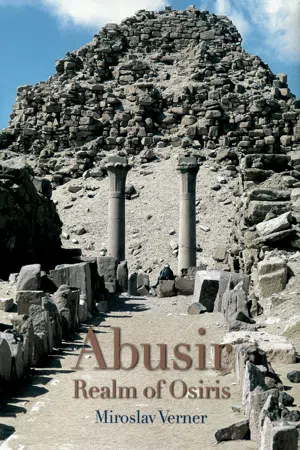
- English
- ePUB (mobile friendly)
- Available on iOS & Android
eBook - ePub
About this book
At the center of the world-famous pyramid field of the Memphite necropolis there lies a group of pyramids, temples, and tombs named after the nearby village of Abusir. Long overshadowed by the more familiar pyramids at Giza and Saqqara, this area has nonetheless been the site, for the last forty years, of an extensive operation to discover its past.
This exciting new book-richly endowed with black-and-white historical photographs, color plates of contemporary work, and informative illustrations-at last documents the uncovering by a dedicated team of Czech archaeologists of a hitherto neglected wealth of ancient remains dating from the Old Kingdom to the Late Period. This is Abusir, realm of Osiris, God of the dead, and its story is one of both modern archaeology and the long-buried mysteries that it seeks to uncover.
Frequently asked questions
Yes, you can cancel anytime from the Subscription tab in your account settings on the Perlego website. Your subscription will stay active until the end of your current billing period. Learn how to cancel your subscription.
At the moment all of our mobile-responsive ePub books are available to download via the app. Most of our PDFs are also available to download and we're working on making the final remaining ones downloadable now. Learn more here.
Perlego offers two plans: Essential and Complete
- Essential is ideal for learners and professionals who enjoy exploring a wide range of subjects. Access the Essential Library with 800,000+ trusted titles and best-sellers across business, personal growth, and the humanities. Includes unlimited reading time and Standard Read Aloud voice.
- Complete: Perfect for advanced learners and researchers needing full, unrestricted access. Unlock 1.4M+ books across hundreds of subjects, including academic and specialized titles. The Complete Plan also includes advanced features like Premium Read Aloud and Research Assistant.
We are an online textbook subscription service, where you can get access to an entire online library for less than the price of a single book per month. With over 1 million books across 1000+ topics, we’ve got you covered! Learn more here.
Look out for the read-aloud symbol on your next book to see if you can listen to it. The read-aloud tool reads text aloud for you, highlighting the text as it is being read. You can pause it, speed it up and slow it down. Learn more here.
Yes! You can use the Perlego app on both iOS or Android devices to read anytime, anywhere — even offline. Perfect for commutes or when you’re on the go.
Please note we cannot support devices running on iOS 13 and Android 7 or earlier. Learn more about using the app.
Please note we cannot support devices running on iOS 13 and Android 7 or earlier. Learn more about using the app.
Yes, you can access Abusir by Miroslav Verner in PDF and/or ePUB format, as well as other popular books in History & African History. We have over one million books available in our catalogue for you to explore.
Information
CHAPTER I
In the Shadow of Memphis
Flooded with sunlight, the landscape of the Nile Valley is a network of irrigation canals interwoven with a many-colored mosaic of fields, villages, gardens, and palm groves. The area around the village of Mit Rahina, not far from the famous Step Pyramid at Saqqara, is no exception. At first sight there is almost nothing to suggest that it was here, almost within sight of the high-rise buildings of Cairo, which encroach ever campaigns to the Western Asia. It was a city which, at the height of its prosperity, extended over an area of approximately 50 square kilometers, but which then vanished almost without trace. The efforts of the archaeologists who have been attempting to unearth its secrets since the beginning of the last century resemble in some ways the proverbial drop in the ocean but have nevertheless continued to bring us new discoveries and new knowledge. The history of the magnificent city has not been lost forever.
Meni, the legendary unifier of Egypt and founder of the First Dynasty, who is credited with the founding of Memphis, could scarcely have chosen a more suitable site on which to build an administrative center for the newly established state. He selected a place on the southern bank of the Nile near the point at which the river valley spreads out into its delta. Just a few kilometers to the north, the Nile, whose course has shifted three kilometers east over the last five thousand years, divides into the branches that determine the basic shape of the Delta. To the east and west the narrow, rocky banked valley, is surrounded by the immense desert. The city which Meni founded was called Ineb(u) hedj, “The White Wall(s),” perhaps because the ramparts of the stronghold which at the same time served as the royal residence, were white. The precise site of this historic center of Memphis has not yet been located with any certainty, although the latest British archaeological researches, using deep-hole drilling, have indicated that it could lie under the northern part of the present-day village of Mit Rahina. At any rate, the remains of “the White Wall” and of later Memphis, lie under several meters of Nile mud.
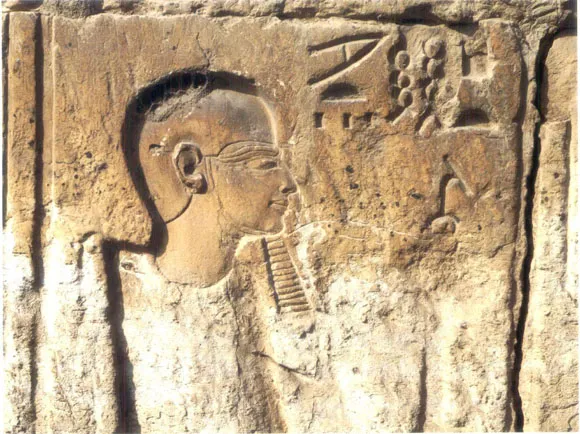
The god Ptah, Lord of Memphis. Detail of sunk relief from the so-called Small Temple of Ptah of Ramesses II. Kom al-Rabia’a, Mit Rahina (photo: Milan Zemina).
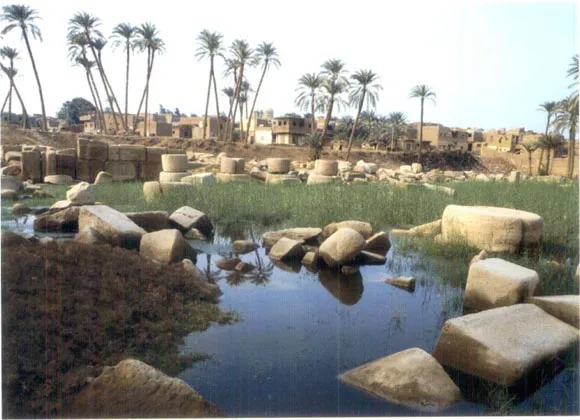
Ruins of the Columned Hall of the Temple of Ptah, Mit Rahina (photo: Milan Zemina).
It is believed that, in addition to the stronghold, Meni also founded a temple of Ptah, the chief god of the new royal seat. Judging by Ptah’s epithet “who-is-south-of-his-wall,” the temple was probably built south of the stronghold “White Wall(s).” Some archaeological finds indicate that the remnants of the early Temple of Ptah may lay under the houses built on a hillock called Kom al-Fakhry. The temple, which gradually became one of the greatest in the land, was called Hutkaptah, “The Temple of the Spirit of Ptah,” and in the later pronunciation Hikupta In its garbled and Graecized form it was the origin of the name Egypt itself. It seems that every Egyptian ruler considered it an obligation to extend and augment the Temple of Ptah with his own buildings, statues, obelisks and other features. As in the case of the Temple of Amon in Karnak, so in Memphis there gradually emerged an enormous temple complex of which only a small part has so far been uncovered and archaeologically investigated. For much information about the Temple of Ptah at Memphis we are indebted to the Greek historian Herodotus, who may have actually visited it in the mid-fifth century BCE. The ancient Egyptians regarded the god Ptah as the god-creator and the patron of craftsmen and artisans. Ptah with his wife, the lion goddess Sakhmet, and his son Nefertem, formed what is called the Divine Triad of Memphis. Later a complete Memphite religious doctrine developed which concerned the creation of the world on the basis of Ptah.

Plan of the parts of ancient Memphis so far archaeologically investigated.
1. Northern Enclosure;
2. Palace of Apries; Enclosure of Ptah;
4. Pylon and hypostyle hall;
5. Embalming house of Apis-bulls;
6. Tombs of high-priests of Memphis;
7. Temple of Ramesses II;
8. Temple of Hathor;
9. Colossus of Ramesses II;
10. Temple of Ramesses II;
11. Alabaster Sphinx (perhaps of Amenhotep II);
12. Palace of Merenptah.
A major contribution to the development of the Temple of Ptah was made by Ramesses II, from whose reign date a number of the parts of the building that have so far been uncovered. These include the hypostyle hall and the South Gate, on which colossal statues of the pharaoh once stood accompanied by other figures. Work on extending the Temple of Ptah proceeded into the Ptolemaic Dynasty. Besides Ptah and his triad, other deities were worshipped in Memphis, first among them being Hathor, the goddess of love and beauty and the guardian of the family. There were also non-Egyptian deities, whose cults were practiced by the numerous foreigners living in Memphis. One important Memphis deity was the sacred bull Apis, regarded as the earthly incarnation of the god Ptah. His temple has not yet been discovered, but a building in which embalming and mummification ceremonies were carried out on the sacred bulls has been found. Enormous alabaster embalming tables decorated with lion figures were found within it. The mummies of the sacred bulls were buried not far away, in North Saqqara, in the underground catacombs of the Serapeum, which was once linked with Memphis by means of an alley of sphinxes.
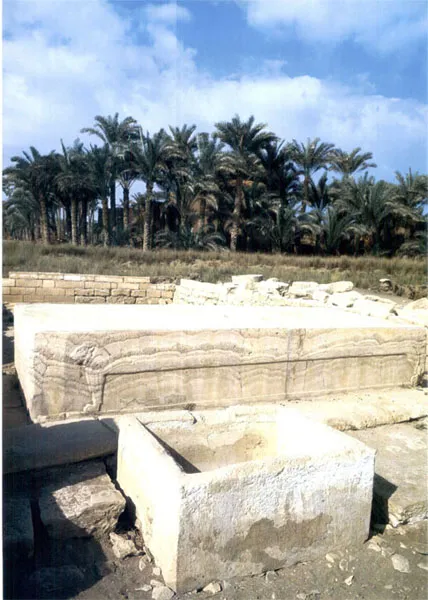
Alabaster embalming table. The so-called Embalming House of the Sacred Apis Bulls from the reign of Sheshonq I. Mit Rahina (photo: Milan Zemina).

Ruins of the Palace of Apries from the Twenty-sixth Dynasty. Mit Rahina (photo: Milan Zemina).
The district of the Temple of Ptah constituted the southern center of Memphis. A second center, a few kilometers to the north, was later formed around the district of the Palace of Apries. Apries, the Egyptian equivalent of the Greek name pronounced “Haaibre,” was a relatively powerful pharaoh of the Twenty-sixth Dynasty. He built a fort in Memphis that had a rectangular ground plan and a massive enclosure wall. He constructed a large palace at the northeast corner of the fort on a raised platform. The platform, the major part of the other buildings making up the Apries Palace, and the fort were all built out of mud bricks. It is possible that this building material, which at the time of the destruction of the monuments attracted less interest than did the various kinds of stone, contributed to the survival of the ruins of the Apries Palace, which were preserved up to a height of approximately ten meters. The mound of the Palace ruins is now the highest place in Memphis. Looking westward from the top of the mound the view is a unique panorama of the Memphite necropolis and the pyramids that dominate it.
From ancient Egyptian written material we know that Memphis was the capital of Egypt throughout the entire period of the Old Kingdom, i.e. almost to the end of the third millennium BCE. It was even, briefly (in the period after the collapse of Akhhaten’s experiment in reform) the capital in the New Kingdom. Even in the periods when it was not the capital city, Memphis maintained its status as an important administrative and religious center, especially for the northern and central parts of the country. It continued to be the biggest city in Egypt. Its fame only dwindled conclusively in the first centuries CE when the half-crumbled and deserted temples and palaces of Memphis were transformed into a large quarry from which building material could be obtained cheaply. After the occupation of Egypt by the army of Amr Ibn al-Aas in 641, the fortress of Fustat was built from the ruins of Memphis on the site of the fallen Byzantine stronghold Babylon, a place that was later to be the site of a new capital city: Cairo.
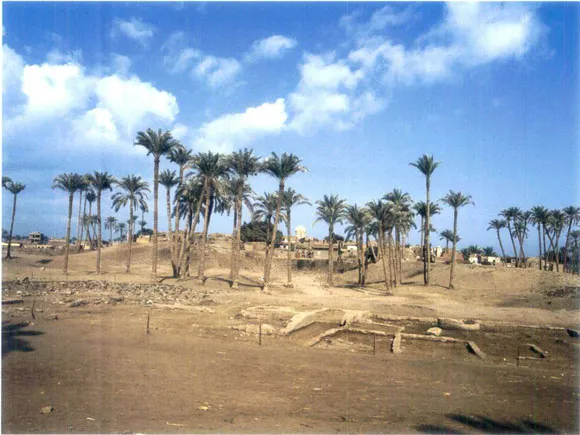
View of Kom al-Fakhry. The older part of the complex of the Temple of Ptah is believed to lie under this hill. Mit Rahina (photo: Milan Zemina).
Research has made it possible to identify more than a hundred archaeological locations in the area covered by ancient Memphis. So far, the oldest antiquities uncovered are the remains of a residential area and artisans’ workshops dating from as early as the First Intermediate Period and beginning of the Middle Kingdom. They were discovered near Kom al-Fakhry. It has not proved possible to find monuments from the third millennium BCE yet, although there must once have been a very large number of these. The Old Kingdom, after all, which was the “era of the pyramid-builders,” was the age of the greatest flowering of Memphis.
The monuments, undoubtedly very diverse, were located at city sites which were often quite distant from one another. Attached to them were groups of administrative and residential buildings, which, despite their peripheral position, were very important. These grew up in the vicinity of the valley temples of the royal pyramid complexes on the edge of the desert. Some of these so-called “pyramid towns” temporarily acquired extraordinary importance. One example is the pyramid town near the valley temple of Teti, first ruler of the Sixth Dynasty, in North Saqqara. Insofar as its position was concerned it was just a suburb a few kilometers from the Temple of Ptah, but for a certain time during the first Intermediate Period it became the politico-administrative center of Egypt. Similarly, it is believed that at the end of the Sixth Dynasty and especially at the beginning of the Middle Kingdom, importance was acquired by that part of the capital which spread out to the environs of the valley temple of Pepi I, in what today is South Saqqara. The pyramid complex of Pepi I was called Men-nefer-Pepi, “The beauty of Pepi is enduring.” The shortened form of this name, Men-nefer Memphis” in Greek, began to be used to designate the whole capital city from the time of the Middle Kingdom. It is somehow fitting that it was a pyramid whic...
Table of contents
- Cover
- Halftitle Page
- Title Page
- Copyright
- Dedication
- Contents
- Preface
- Chapter I: In the Shadow of Memphis
- Chapter II: Abusir—the Rise of a Royal Necropolis
- Chapter III: Under the Sign of the Sun
- Chapter IV: The Royal Mother
- Chapter V: The Secret of the Unfinished Pyramid
- Chapter VI: The Testimony of the Papyrus Archives
- Chapter VII: The Dazzling Career of the Royal Hairdresser
- Chapter VIII: The Traitor’s Tomb?
- Chapter IX: Iufaa—an Intact Tomb!
- Chapter X: South Abusir: at the Crossroads of History
- Chapter XI: In Search of Lost Time
- Chronological List of Rulers and Dynasties
- Select Bibliography
- Index
- Back Cover